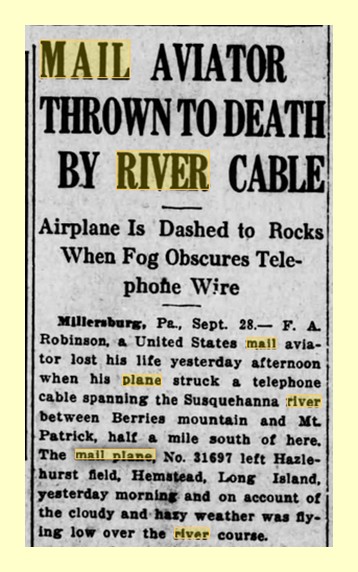MAIL AVIATOR THROWN TO DEATH BY RIVER CABLE
Airplane is Dashed to Rocks When Fog Obscures Telephone Wire
Millersburg, Pennsylvania, September 29 [1920] – F. A. Robinson, a United States mail aviator lost his life yesterday afternoon when his plane struck a telephone cable spanning the Susquehanna River between Berries Mountain and Mt. Patrick, half a mile south of here. The mail plane, No. 21697 left Hazelhurst Field, Hempstead, Long Island, yesterday morning and on account of the cloudy and hazy weather was flying low over the river course.
Loops After Crash
Herbert L. Kuhns, driving in the Narrows, and Howard Kahler, in a canoe fishing, about a quarter of a mile from the accident, say that when the plane struck the wire the impact threw the nose of the machine up into the air, and that before it struck the rocks in the river below, the nose swung around and struck head first. Kuhns heard the pilot cry out, and crossed the tracks and the old canal bed where he could see the wreck 125 years out in the river close by what is known as Shore Island. Kuhns says the aviator was moaning, but soon after became silent. He hurried to Millersburg for help.
Dr. D. E. Hottenstein, Palmer Brown a substitute clerk in the Millersburg Post Office, Clyde Cromley and others hastened to the wreck in automobiles, and finding a canoe went to the place at once. A glance showed that the man was dead and that death had come almost instantaneously. The marks on his face showed a bad gash near the eye, where it is thought, a part of his eyeglasses penetrated the brain, one of his legs was also broken.
In a short time hundreds of Millersburgers had gotten to the place. Postmaster Rubendall telegraphed to the Harrisburg Post Office about the mail and was instructed to send it on at once, which he did. The mail sacks numbered 14. Brown, who was one of the first on the scene, and who is a substitute mail man, fished many packages of letters from the river, which had began to float away.
___________________________________
From the Harrisburg Telegraph, 28 September 1920, via Newspapers.com.
Corrections and additional information should be added as comments to this post.
